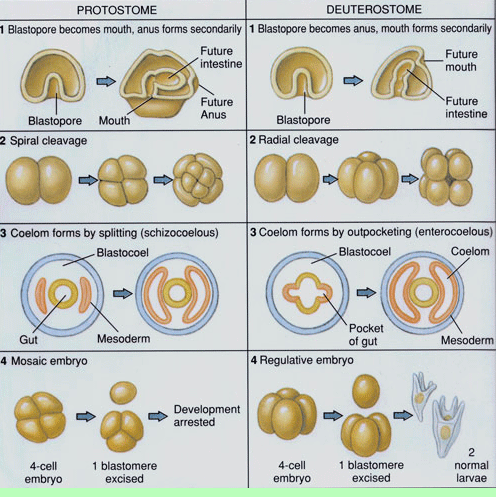Formally defined by Valentine in 1986 as assemblages of homologous architectural and structural features distinguishing phyla (clades) and classes.
1.It is more than a body plan because it considers the architectural limits of any structure, as well as the functional aspects of any design. It is the way that goups of animals accomplish certain basic tasks, such as acquirement of food.
2. It incorporates the idea that there are a limited number of ways to do this, or to put together tissues and organs in the form of “animals” to do this. There are a potentially bewildering diversity of invertebrate species, yet among these there appears to be only about 35-36 basic designs. Some are more common than others, why? What goes together and what does not? For example, we will learn that haemocoels (hemocoels) and open circulatory systems, just as eucoeloms and closed circulatory systems, just seem to go together.
3. Bauplans will always be important for identification of specimens. There will always be the practical consideration that if you encounter an invertebrate, you will need ways to identify it and this will be by characteristics that relate to structure or function. Also, there are few groups or clades also that are defined by structural or functional characteristics. Cnidarians for example are defined by stinging cells, cnidocytes, that contain nematocysts.
4. That said, Valentine's ideas on features of existing bauplans representing true homologies (characteristics inherited from ancestors) has been for the most part refuted. There is now ample evidence that characteristics that were used in the past as homologous bauplan features (such as segmentation), are now known to have evolved anew in several different lines.
For example, you learned in BIO 181 that annelids (earthworms and polychaetes) were segmented. Add division of segments into more functional units and jointed appendages and you have an arthropod. This pathway to insects makes sense and this was actually the evolutionary pathway initially proposed by invertebrate biologists. Unfortunately, there is now ample evidence that segmentation arose independently in annelids and insects and that the lines leading to these groups split before segmentation in either appeared. Annelids now are thought more related to molluscs, and insects are more related to of all things, nematodes, and other things unsegmented, that molt.
5. Most of modern classification of invertebrates is dictated by molecular analysis, most by ribosomal sequence comparisons between larger groupings or clades. The hope is that molecular analysis will lead to sequencing of important genes and evidence of how their expression is changed through development to give us the bauplans that we observe in nature. New data on genetics and development indicate that many of the basic body plans are being traced to genes and developmental pathways that evolved and have been conserved for 500 million years. That any differences we observe in changes in body plans have been accompanied by relatively modest tinkering with the machinery of early development. This viewpoint however is relatively new and it will take more research to document the relationship between changing gene expression in development and existing bauplans.
An interesting example considering we were discussing segmentation in point 4. Antp and Ubs are two patterning genes. Both are expressed during development in insects and crustaceans. However,expression of both within the region of the abdomen suppresses limb formation in insects.
So now researchers are focusing on examining differences in timing and gradients in regulatory molecules, that lead to differences in development, and so overall structure.
6. Changes in development were always thought to play a role in determining bauplans. However, it was not differential gene expression that early invertebrate biologies focussed on, but the actual stages of development. They felt that early animal evolution proceeded by addition of structures we see added in sequence in development. This viewpoint also incorporated the assumption that animal evolution proceeded from simple to complex, and we can use as models for that progression, existing forms. The problem is that new research has determined that existing simpler forms in most clades appear to be derived (evolved later) forms. So for example, anemones, which are the most structural complex of the Cnidarians, are the oldest forms as evidenced by molecular and fossil data. Some invertebrate biologists feel some anemone species even posses three layers and true muscles. Hydroid forms (such as Hydra) with simple two layer sac like bodies are the newcomers. This new research has lead to a dramatic change in the way we look upon relatedness and evolution among the invertebrates.
__________________________________________________________________________________
Here are some old ways of looking at invertebrate evolution. Please do not memorize. These are wrong. You will, however, encounter these diagrams and terms in old invertebrate textbooks and even new introductory biology and zoology texts.
Example one: Simple to complex as a way we get bigger animals. This viewpoint is not substantiated by molecular data.
Example two: Still dearly favored by most introductory texts on vertebrates.
Deuterostome characteristics listed are not that bad and still apply to what we consider older groups. Protostome characteristics do not apply to the most abundant groups, old and new, that were always considered protostomes, such as arthropods.
______________________________________________________________________________________


